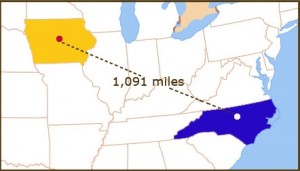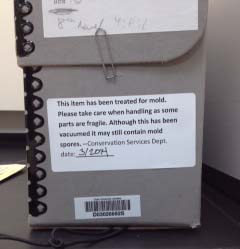I love the older starch-filled buckrams you find in the stacks. You can drive a truck over it but you can’t destroy it. Unless you are mold hyphae. Then it is nothing more than a delicious snack.

 Mold and mold removal is a complex issue. Covering everything you should know about mold would take much more than this blog post. There are good references out there if you are interested in learning more.
Mold and mold removal is a complex issue. Covering everything you should know about mold would take much more than this blog post. There are good references out there if you are interested in learning more.
Our stacks are fairly well controlled for both temperature and humidity so we don’t find mold growing in the stacks unless there has been an undetected environmental problem. Most often mold is identified during archival processing or at circulation points.
Since 2003 we have removed mold from over 5,900 library items. That number will rise significantly this year as I recently finished drying and cleaning over 1,800 items from a large manuscript collection.
For rare and archival items we will do what we can to clean any mold from the collection. Mold must be dormant before attempting to remove it. Small amounts of materials can be dried quickly in the fume hood. Larger amounts of wet materials are put in the freezer until both the paper and the mold are dry.
Once the mold is dry and powdery, the spores can be carefully removed from the paper’s surface either with a dry cleaning sponge or HEPA vacuum. You must be careful with these techniques since you don’t want to drive spores deep into the paper or damage the already weak paper by being too rough with it. Even after treating the surface spores, there may still be spores imbedded deep in the paper fibers. Staining can also be left due to the “biological output” of the mold. These stains may be difficult or impossible to remove. If necessary, after dry cleaning we may wash the paper in an alcohol/deionized water solution.
When we are finished cleaning an item, we apply a label to the box alerting our patrons to the fact the collection was moldy. We believe it is best practice to alert patrons so that they may determine their own best course of action when handling these materials. The library is happy to provide personal protective equipment (PPE) such as gloves and a mask if anyone is concerned about handling these materials.

We will clean circulating items that have mold only on a few pages, or send them to the commercial bindery if the mold is isolated on the covers. If the mold is extensive we will talk to Collection Development to determine if a replacement can be purchased. If it cannot be replaced, we will treat it the best we can, or we may decide collaboratively to remove it from the collection because the damage is too great.
You can build up an allergy to mold and some of those allergies can be severe. To avoid that, we make sure we are protected from mold exposure as much as possible.
We work with very moldy items in our fume hood to reduce the risk of spores getting into the lab. We wear protective nitrile gloves and we make sure our face is protected by the fume hood sash. When the project is over, we clean our tools and the fume hood with soap and water, followed by an Isopropyl alcohol wash. We then thoroughly wash our hands.
If we are working on site somewhere, we wear protective gloves, N-95 respirators, and long-sleeved shirts and pants that can be washed in warm, soapy water. For extra protection, goggles can be worn to protect your eyes. It is best practice to always wear PPE when handling moldy materials.
*I know I’m not wearing gloves in the picture above. Don’t be like me.
Mold can thrive in a variety of environments, even in the Antarctic. To reduce the risk of mold in your collections:
No post about mold would be complete without my favorite moldy item that has come to Conservation. I am talking, of course, about the banana book. Isn’t it something to behold?
Let’s head over to Parks Library Preservation to see what sort of moldy things they have encountered.